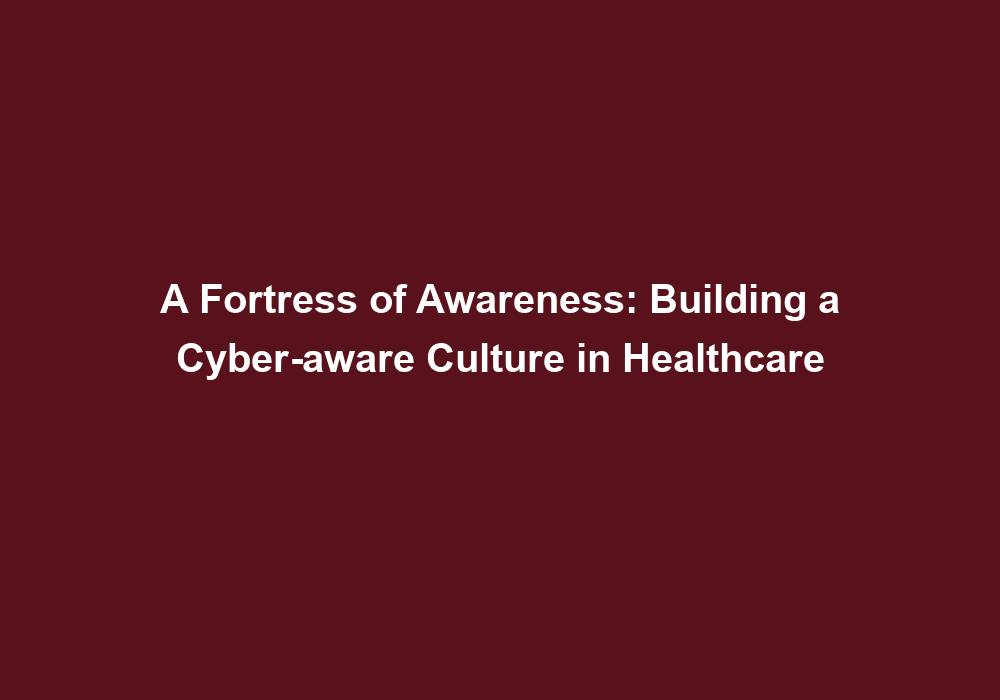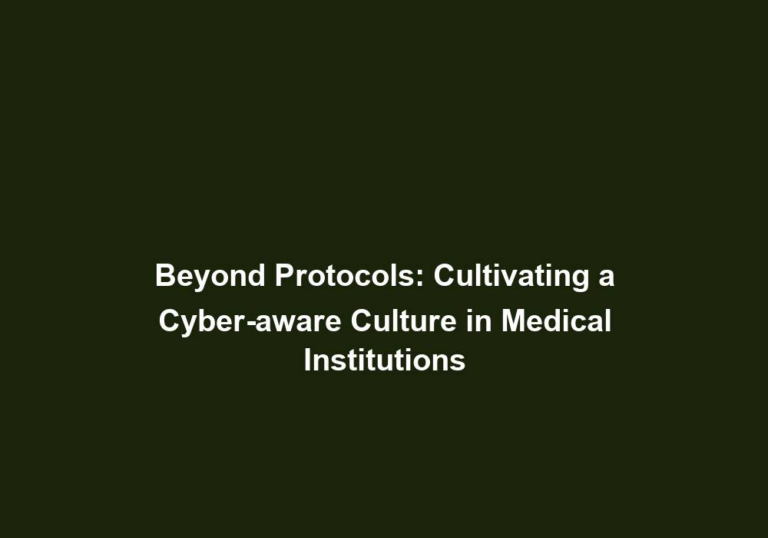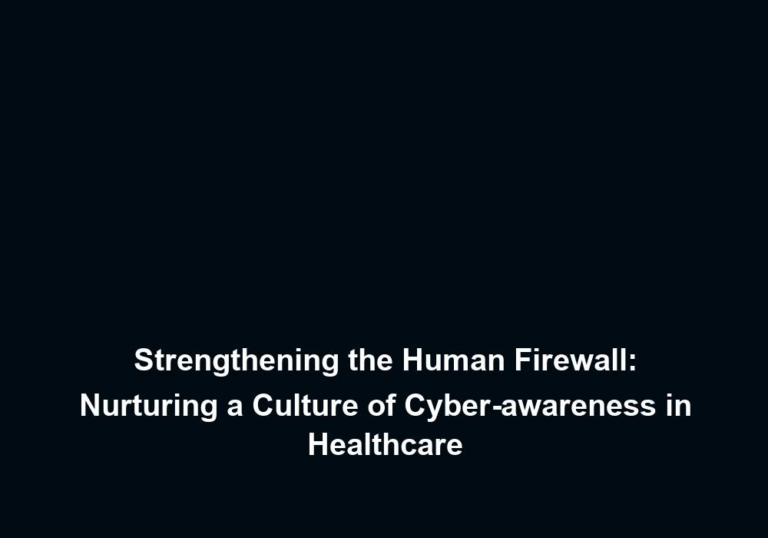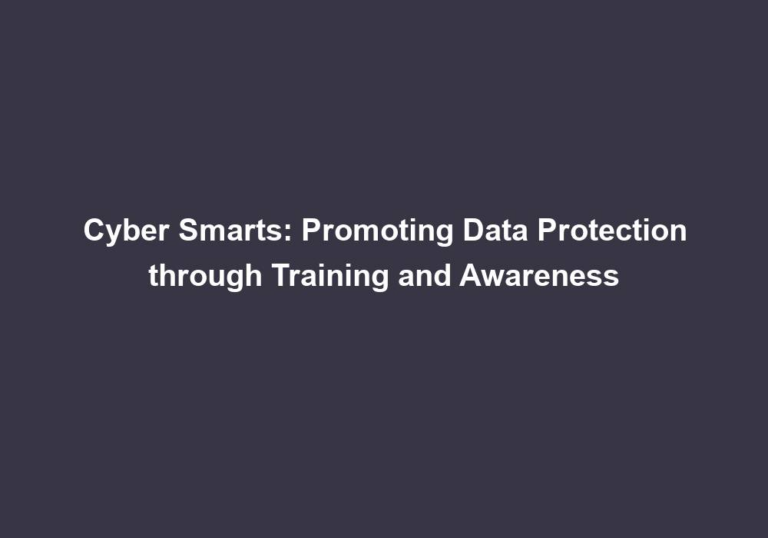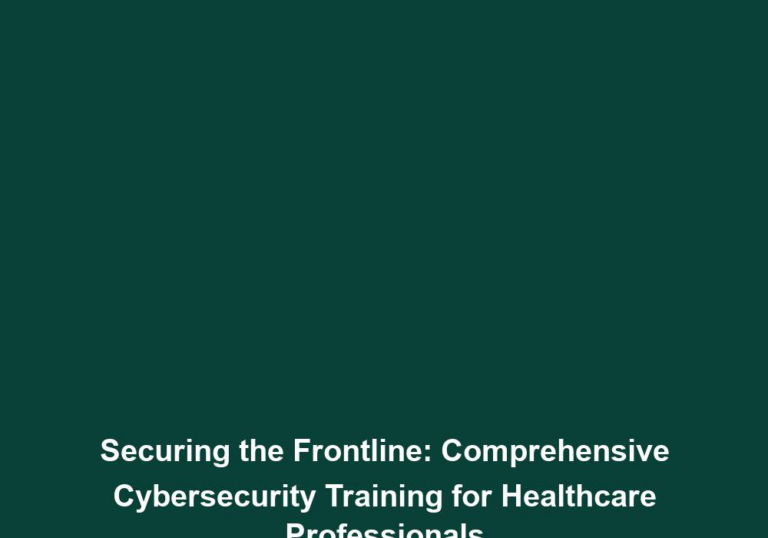A Fortress of Awareness: Building a Cyber-aware Culture in Healthcare
In today’s digital age, the healthcare industry has become increasingly reliant on technology to improve patient care, streamline processes, and store sensitive medical information. However, this rapid advancement has also made healthcare organizations vulnerable to cyber threats and attacks. To safeguard patient data and ensure the integrity of healthcare systems, it is crucial to build a cyber-aware culture within the industry. By raising awareness and implementing robust security measures, healthcare organizations can fortify their defenses and protect against cyber threats.
The Growing Cybersecurity Challenge in Healthcare
With the advancements in technology, healthcare organizations have digitized medical records, implemented electronic health records (EHRs), and interconnected medical devices for efficient healthcare delivery. While this digital transformation has revolutionized the industry, it has also created new security risks.
- Increased Vulnerability: Cybercriminals view healthcare organizations as attractive targets due to the sheer volume of sensitive patient data they possess. This includes personal health information (PHI), financial records, and insurance details. The potential for financial gain by accessing and selling this data on the dark web makes healthcare an appealing cybercrime target.
Healthcare organizations store vast amounts of sensitive patient data, making them an attractive target for cybercriminals. This data includes personal health information (PHI), financial records, and insurance details. The potential financial gain for cybercriminals who access and sell this data on the dark web is a significant driving force behind attacks on healthcare organizations. By infiltrating the healthcare industry, cybercriminals can exploit vulnerabilities in systems and gain unauthorized access to valuable data.
- Sophisticated Attacks: Cybercriminals are constantly evolving their tactics to breach healthcare systems. They employ methods like phishing, ransomware, and malware attacks to gain unauthorized access to sensitive data. These attacks can disrupt healthcare operations, compromise patient safety, and lead to financial losses.
Cybercriminals are becoming increasingly sophisticated in their attacks on healthcare organizations. They employ various tactics, such as phishing, ransomware, and malware attacks, to gain unauthorized access to sensitive data. Phishing attacks involve tricking employees into revealing confidential information, while ransomware attacks encrypt data and demand a ransom for its release. Malware attacks involve the installation of malicious software that can compromise the integrity of healthcare systems. These attacks can have severe consequences, disrupting healthcare operations, compromising patient safety, and causing financial losses.
- Insider Threats: Healthcare organizations are not only vulnerable to external threats but also face risks from within. Disgruntled employees or negligent staff members can unintentionally compromise security by falling victim to phishing attempts or improperly handling sensitive data. Building a cyber-aware culture addresses this internal threat as well.
In addition to external threats, healthcare organizations also face risks from within their own workforce. Disgruntled employees or negligent staff members can unintentionally compromise security by falling victim to phishing attempts or mishandling sensitive data. It is essential to build a cyber-aware culture that educates employees about the risks and consequences of their actions. By fostering a sense of responsibility and vigilance, healthcare organizations can mitigate the risk of insider threats and ensure that all staff members are actively engaged in maintaining a secure environment.
The Importance of a Cyber-aware Culture
To effectively combat cyber threats, healthcare organizations must prioritize cybersecurity and foster a cyber-aware culture. This culture encompasses a proactive approach to security, where all employees are educated, vigilant, and responsible for safeguarding sensitive data.
Benefits of a Cyber-aware Culture
Embracing a cyber-aware culture offers several benefits to healthcare organizations:
- Enhanced Security: By educating employees about potential threats and providing clear guidelines for secure behavior, healthcare organizations can significantly reduce the risk of security breaches. A cyber-aware culture promotes a proactive and vigilant workforce that can identify and report suspicious activities promptly.
Implementing a cyber-aware culture within healthcare organizations enhances overall security. By educating employees about potential threats and providing clear guidelines for secure behavior, organizations empower their workforce to actively contribute to the protection of sensitive data. Employees who are educated about cybersecurity best practices can recognize and report suspicious activities promptly, minimizing the risk of security breaches. A proactive and vigilant workforce is a crucial component of a robust cybersecurity strategy.
- Reduced Legal and Financial Risks: Data breaches can have severe legal and financial consequences for healthcare organizations. By establishing a cyber-aware culture, organizations can mitigate these risks by implementing robust security measures, complying with industry regulations, and avoiding costly data breaches.
Data breaches can result in significant legal and financial risks for healthcare organizations. The loss or unauthorized access of patient data can lead to legal action, regulatory fines, and reputational damage. By building a cyber-aware culture, healthcare organizations can mitigate these risks by implementing robust security measures and complying with industry regulations. A proactive and vigilant workforce can help prevent data breaches, minimizing potential legal and financial liabilities.
- Protection of Patient Trust: Patients trust healthcare organizations to protect their sensitive information. A robust cyber-aware culture demonstrates the organization’s commitment to protecting patient privacy and fosters trust among patients, leading to improved patient satisfaction and loyalty.
Patients entrust healthcare organizations with their sensitive and personal information. Establishing a cyber-aware culture demonstrates an organization’s dedication to protecting patient privacy. When patients have confidence in the security of their data, it fosters trust and enhances their overall satisfaction with the healthcare provider. By building a cyber-aware culture, healthcare organizations can strengthen patient trust, leading to increased patient satisfaction and loyalty.
Building a Cyber-aware Culture
Creating and nurturing a cyber-aware culture within healthcare organizations requires a comprehensive approach that addresses various aspects of cybersecurity.
Training and Education
- Employee Awareness Programs: Conduct regular training sessions to educate employees about cybersecurity best practices, including identifying phishing attempts, creating strong passwords, and recognizing social engineering tactics. Reinforce the importance of cyber hygiene and the potential consequences of security breaches.
Regular training sessions should be conducted to educate employees about cybersecurity best practices. These sessions should cover topics such as identifying and avoiding phishing attempts, creating strong and unique passwords, and recognizing social engineering tactics. It is essential to reinforce the importance of cyber hygiene and emphasize the potential consequences of security breaches. By educating employees, organizations empower them to become the first line of defense against cyber threats.
- Role-based Training: Tailor training programs to specific roles within the organization. For example, medical staff should receive training on protecting patient data during telemedicine consultations, while IT personnel should receive advanced training on system vulnerabilities and incident response.
Training programs should be tailored to specific roles within the organization. For example, medical staff should receive training on protecting patient data during telemedicine consultations, ensuring compliance with privacy regulations. IT personnel, on the other hand, should receive advanced training on system vulnerabilities, incident response, and the latest cybersecurity trends. By providing role-based training, organizations equip employees with the knowledge and skills necessary to address cybersecurity risks specific to their roles.
- Continuous Education: Cybersecurity threats are constantly evolving. Ensure that training programs are regularly updated to address new threats, technologies, and compliance requirements. Encourage employees to stay abreast of the latest developments through relevant workshops, webinars, and online resources.
Cybersecurity threats are continuously evolving, and it is crucial to keep training programs up to date. Regularly review and update training materials to address new threats, emerging technologies, and changing compliance requirements. Encourage employees to stay informed about the latest developments in cybersecurity through workshops, webinars, and online resources. By promoting continuous education, healthcare organizations can ensure that their workforce remains knowledgeable and prepared to tackle evolving cyber threats.
Robust Policies and Procedures
- Security Policies: Develop and enforce clear security policies that outline expected employee behavior, use of company resources, and consequences for non-compliance. Include policies on password management, data encryption, remote access, and third-party vendor security.
Developing and enforcing clear security policies is essential to establish a cyber-aware culture. These policies should outline expected employee behavior, including guidelines for the use of company resources and the consequences of non-compliance. Password management policies, data encryption policies, policies on remote access, and guidelines for third-party vendor security should also be included. By implementing robust security policies, organizations promote a culture of security and ensure consistent adherence to best practices.
- Incident Response Plan: Establish an incident response plan that outlines the steps to be taken in the event of a security incident or breach. Regularly test and update the plan to ensure its effectiveness. This will help minimize the impact of an incident and facilitate a swift and coordinated response.
An incident response plan is a crucial component of a cyber-aware culture. This plan should outline the steps to be taken in the event of a security incident or breach, including communication protocols, incident containment procedures, and recovery strategies. It is essential to regularly test and update the plan to ensure its effectiveness. By having a well-defined incident response plan in place, healthcare organizations can minimize the impact of an incident and facilitate a swift and coordinated response.
- Secure Remote Work: With the rise of remote work, implement policies and guidelines for secure remote access to healthcare systems. This includes the use of virtual private networks (VPNs), multi-factor authentication (MFA), and secure file sharing platforms.
The rise of remote work in the healthcare industry necessitates the implementation of secure remote access policies. Healthcare organizations should establish guidelines for remote access, including the use of virtual private networks (VPNs) to encrypt data transmission, multi-factor authentication (MFA) to verify user identity, and secure file sharing platforms to ensure the confidentiality of sensitive information. By implementing secure remote work policies and guidelines, healthcare organizations can protect patient data and maintain the integrity of their systems in a remote work environment.
Technology and Infrastructure
- Secure Network Design: Implement robust network security measures, including firewalls, intrusion detection systems (IDS), and secure wireless networks. Regularly monitor network activity to detect and respond to potential threats promptly.
Implementing robust network security measures is crucial to establish a cyber-aware culture. This includes the use of firewalls, intrusion detection systems (IDS), and secure wireless networks. Regularly monitoring network activity allows organizations to detect and respond to potential threats promptly. By implementing secure network design practices, healthcare organizations can create a strong foundation for their cybersecurity defenses.
- Regular Software Updates: Keep all software, including operating systems, applications, and medical devices, up to date with the latest patches and security updates. Vulnerabilities in outdated software can be exploited by cybercriminals.
Regularly updating software is vital to maintaining a secure environment. This includes keeping operating systems, applications, and medical devices up to date with the latest patches and security updates. Cybercriminals often exploit vulnerabilities in outdated software to gain unauthorized access to systems. By implementing regular software updates, healthcare organizations can minimize the risk of exploitation and ensure that their systems are protected against known vulnerabilities.
- Data Encryption: Encrypt all sensitive data at rest and in transit to protect it from unauthorized access. This includes data stored on servers, databases, laptops, and mobile devices.
Data encryption is a critical component of a cyber-aware culture. Healthcare organizations should encrypt all sensitive data at rest and in transit to protect it from unauthorized access. This includes encrypting data stored on servers, databases, laptops, and mobile devices. By implementing data encryption measures, organizations can ensure the confidentiality and integrity of sensitive information, even in the event of a security breach.
Conclusion
Building a cyber-aware culture is an ongoing process that requires continuous effort and commitment from healthcare organizations. By prioritizing cybersecurity, educating employees, and implementing robust security measures, healthcare organizations can establish a fortress of awareness that protects patient data, ensures the integrity of healthcare systems, and safeguards against cyber threats. Through a collaborative effort, the healthcare industry can strengthen its defenses and create a secure environment for delivering quality patient care in the digital age.

